For gardeners, growing plants from seed can be great fun.
You never know quite what you’re going to get. The plants that spring up from, say, columbine seeds may produce yellow, purple, pink, blue or white flowers.
Variety is great for gardeners. But for farmers, a lack of uniformity in crops can be little short of a nightmare. Instead, they value plants that are all alike.
With the date palm, a history of more than 6,000 years of cultivation in the Middle East counts for little when growers produce the plants from seed: the trees that result take many years to produce fruit, and what they do yield tends to be of poorer quality.
In fact, typically less than 10 per cent of the trees grown in a plantation of seedlings will give the farmer an acceptable amount of good quality dates.
Moreover, only the female trees of the date palm, known by the Latin name Phoenix dactylifera, actually produce the tasty fruit that is so popular in the UAE.
Yet it can take several years before the gender of a plant becomes apparent, meaning valuable time and resources could be spent growing male plants that will not yield a crop.
Standard farming practice has therefore been to propagate date palms vegetatively, from cuttings, because this avoids the sexual reproduction process involved in seed production.
The trees that result from vegetative propagation are genetically identical to the originals, ensuring high yields and top quality dates.
But, according to the UN’s Food and Agriculture Organisation (FAO), a great deal needs to be done to tap the full potential of these methods.
It calls the palms “a much-neglected plant group in terms of understanding their development and vegetative propagation potential”.
Tissue culture methods, in which a small piece of tissue is taken and grown into an adult plant, are among the most useful ways of propagating date palms, with the FAO saying they offer “many advantages” over other methods, such as allowing large-scale multiplication and the propagation of healthy disease-free plants.
And a recent UAE study has shown how current methods can be improved. Scientists from UAE University in Al Ain found they could significantly speed up the tissue culture process, producing potted plantlets in just 11 months – months quicker than previous methods.
The researchers – Mohammed Aly, Geetha Lekshmi and Nadia Hassan Tawfik, led by associate professor Dr Shyam Kurup – cut pieces of leaf-base tissue from the offshoots of the Kheneizi variety of date palm.
The leaf base is the area where a leaf joins a stem, while offshoots are the mini plants that grow from certain buds on the trunks of date palms, similar to the way in which spider plants generate pint-sized versions of themselves on stems.
So far, so straightforward. But this process can be hampered by fungi that attack the new plantlets when they are at their most vulnerable.
To ensure the plantlets develop properly, fungi and any other extraneous organisms need to be removed, by sterilising the surface of the new plantlets, known as leaf-base explants.
Traditionally this has been done by multi-step chemical treatment. Instead of that, Dr Kurup and his colleages simply dipped the trimmed offshoots in alcohol before plunging them in a flame. It is simple, quick – and just as effective.
The growing sections of the offshoots are then cut out and transferred between various nutrient media as they grow. And just 11 months after they started, the plantlets can be planted out in the field.
That’s not the end of it. Dr Kurup believes there is further room for improvement – to as little as eight or nine months, he reckons.
“From the farmers’ point of view, what they want is uniform, disease-free, genuine healthy plant material,” he says. “This way the technique could produce large numbers of plants.
“We now have nearly 100 plants hardened in the greenhouse and an equal number of plants in the incubator waiting for transfer outside.”
The researchers are hoping to patent their technique, and to extend its use to other date palm varieties, such as Ghanam and Zamli.
“With each variety, we may have to have slight refinement of the technique,” Dr Kurup says. “What’s applicable to Kheneizi may not be applicable to Ghanam, but the basic media can be the same. Fine tuning can be made.”
So, six millennia on from the first cultivation of date palms, there is still plenty of room for improvement in how the plants are cultivated. And that, eventually, should mean more, better, cheaper fruit for the UAE’s many date lovers.
newsdesk@thenational.ae







